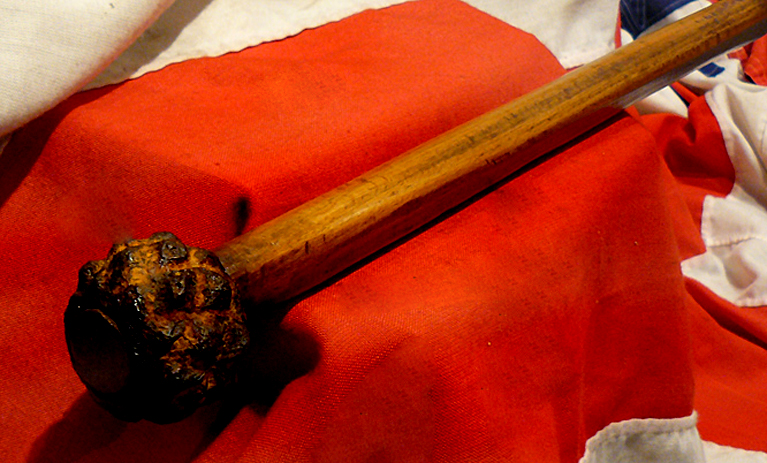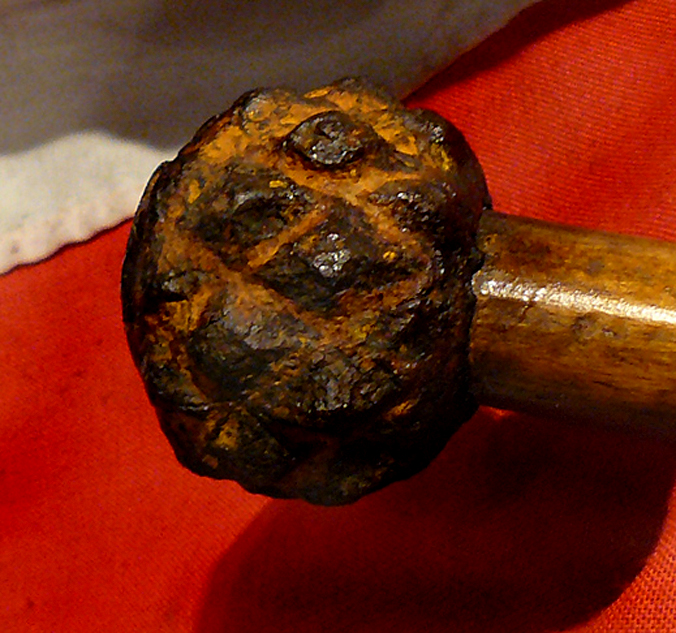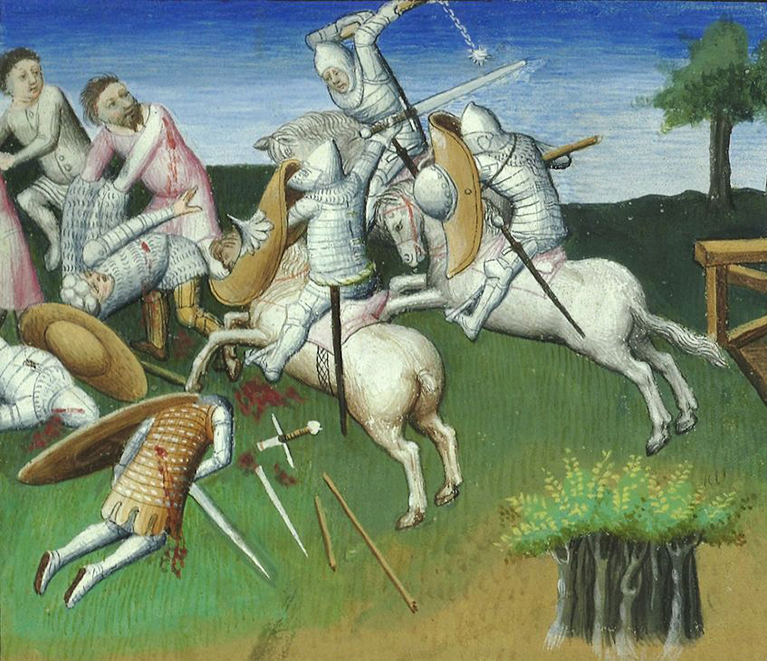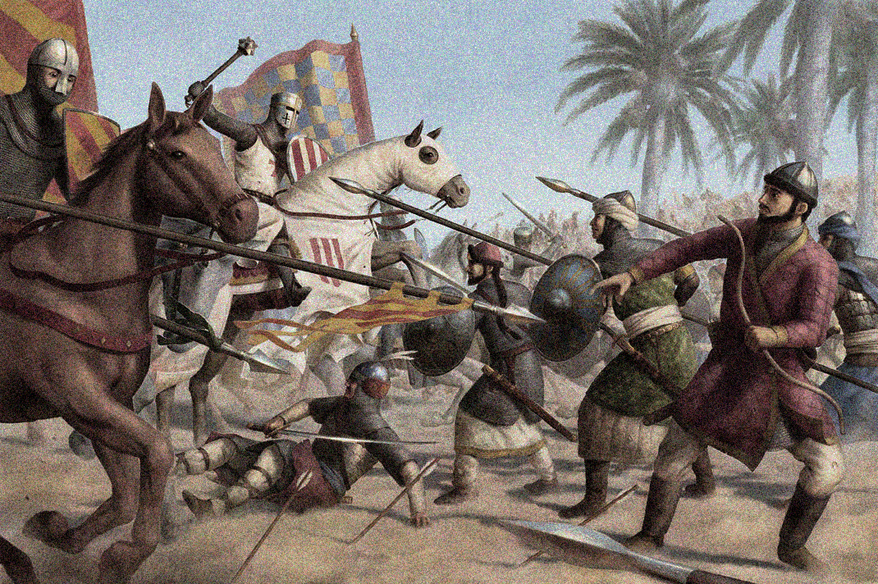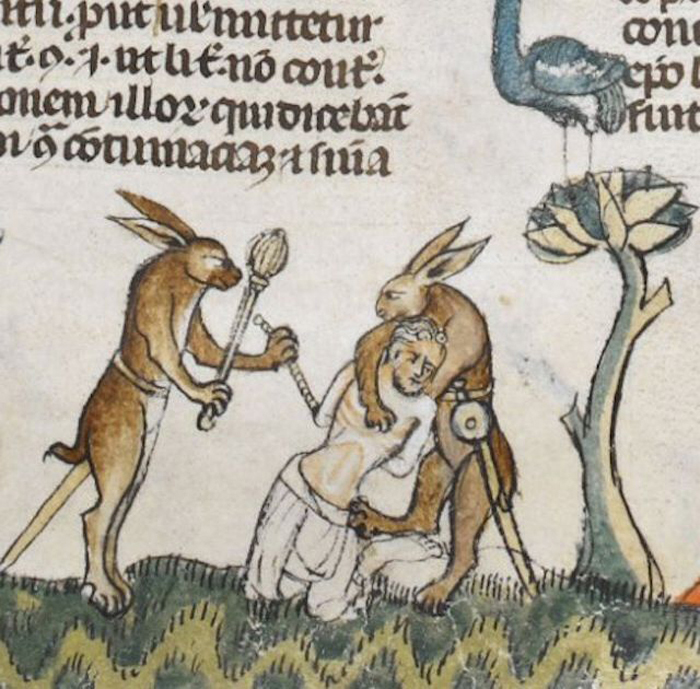A Most Fearsome & impressive Original Medieval Crusaders Battle Mace, 700 to 800 Years Old
A most impressive but fearsome early weapon from the 1200's to 1300's around 700 to 800 years old, and most probably German. On replacement 'display' haft. An incredible elaborate 'pineapple' form lobed head that would be extremely effective at achieving its aim. This is also the form of Mace that could also mounted on a short chain with a haft and then used as a flail mace or scorpian sting for that extra reach while used on horseback. Unlike a sword or haft mounted mace, it doesn't transfer vibrations from the impact to the wielder. This is a great advantage to a horseman, who can use his horse's speed to add momentum to and under-armed swing of the ball, but runs less of a risk of being unbalanced from his saddle. On a Flail it had the name of a Scorpion in England or France, or sometimes a Battle-Whip. It was also wryly known as a 'Holy Water Sprinkler'. King John The Ist of Bohemia used exactly such a weapon, as he was blind, and the act of 'Flailing the Mace' meant lack of site was no huge disadvantage in close combat. Although blind he was a valiant and the bravest of the Warrior Kings, who perished at the Battle of Crecy against the English in 1346. On the day he was slain he instructed his Knights [both friends and companions] to lead him to the very centre of battle, so he may strike at least one blow against his enemies. His Knights tied their horses to his, so the King would not be separated from them in the press, and they rode together into the thick of battle, where King John managed to strike not one but at least four noble blows. The following day of the battle, the horses and the fallen knights were found all about the body of their most noble King, all still tied to his steed.
It is difficult to block with a shield or parry with a weapon such as this on a chain because it can curve over and round impediments and still strike the target. It also provides defence whilst in motion. However the rigid haft does have the advantage as the flail needs space to swing and can easily endanger the wielder's comrades.
Controlling the flail is much more difficult than rigid weapons. Mounted on a replaced old haft. One photo in the gallery is from a 13th century Manuscript that shows knights in combat, and one at the rear is using a stylised and similar Mace [photo for information only and not included with mace]. The head is around the size of a tennis ball. In the gallery is a section of a 13th century illuminated manuscript, The Smithfield Decretals showing two man-sized rabbits killing a restrained man with a mace, known as a 'bizarre and vulgar' illustration. A mace is a blunt weapon, a type of club or virge that uses a heavy head on the end of a handle to deliver powerful blows. A mace typically consists of a strong, heavy, wooden or metal shaft, often reinforced with metal, featuring a head made of stone, copper, bronze, iron, or steel.
The head of a military mace can be shaped with flanges or knobs to allow greater penetration of plate armour. The length of maces can vary considerably. The maces of foot soldiers were usually quite short (two or three feet). The maces of cavalrymen were longer and thus better suited for blows delivered from horseback. Two-handed maces could be even larger. During the Middle Ages metal armour such as mail protected against the blows of edged weapons. Solid metal maces and war hammers proved able to inflict damage on well armoured knights, as the force of a blow from a mace is great enough to cause damage without penetrating the armour. Though iron became increasingly common, copper and bronze were also used, especially in iron-deficient areas. The Sami, for example, continued to use bronze for maces as a cheaper alternative to iron or steel swords.
One example of a mace capable of penetrating armour is the flanged mace. The flanges allow it to dent or penetrate thick armour. Flange maces did not become popular until after knobbed maces. Although there are some references to flanged maces (bardoukion) as early as the Byzantine Empire c. 900 it is commonly accepted that the flanged mace did not become popular in Europe until the 12th century, when it was concurrently developed in Russia and Mid-west Asia.
.It is popularly believed that maces were employed by the clergy in warfare to avoid shedding blood (sine effusione sanguinis). The evidence for this is sparse and appears to derive almost entirely from the depiction of Bishop Odo of Bayeux wielding a club-like mace at the Battle of Hastings in the Bayeux Tapestry, the idea being that he did so to avoid either shedding blood or bearing the arms of war. Iron head 2 inches x 2.25 inches across, length 21 inches
Code: 21134
1350.00 GBP


